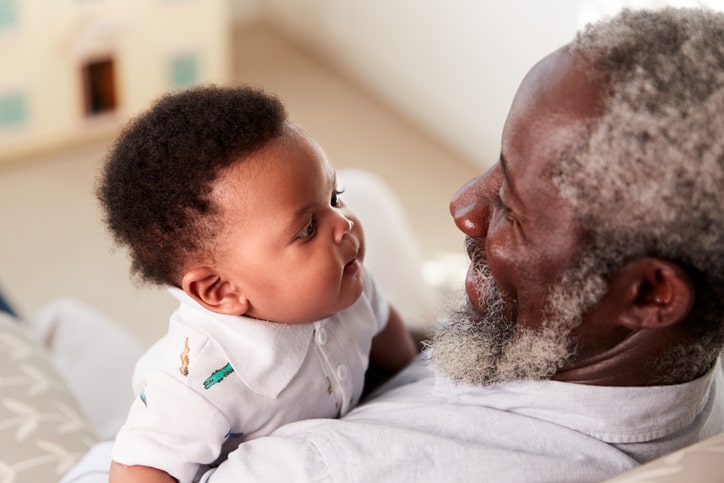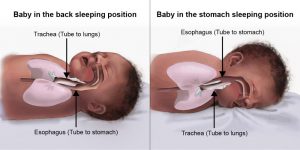
A special message from the Oakland County Health Department for grandparents caring for infant grandchildren
County Health Departments, including the Oakland County Health Division, are working to make sure everyone in a baby’s life (including grandparents) is aware of the dangers of unsafe sleep and ways to reduce the risk of SIDS. In Michigan a baby dies due to an unsafe sleep position or environment every 2-3 days, and in Oakland County a baby dies from unsafe sleep approximately once a month. Our public health nurses frequently educate mothers about the importance of safe sleep, but we know they aren’t the only ones caring for their infants, and we need everyone’s help to prevent these tragic losses.
We recognize the “rules” of putting babies to sleep have changed over the years. Many of us were put to sleep on our sides or stomachs or wrapped up in blankets with our favorite stuffed animals. We look pretty cute in those old photos, but over the years we’ve learned a lot about what increases the risk of SIDS, and we’ve learned a lot of deaths that were called “crib death” or SIDS could have been due to how or where baby was sleeping.
 In the 1990s, a national Back to Sleep campaign started to teach families to always place their babies to sleep on their backs. We learned babies are less likely to choke on spit up if they are lying on their back than if they are on their stomach. This is because our airways are in front of our esophagus, the “food tube,” and when a baby is on his stomach the airway is on the bottom, so any spit up will follow gravity and go into the lungs. On his back, the esophagus is on bottom, so gravity will send spit up back into the stomach. Here’s a short illustration of how this happens. Back vs Stomach Sleeping
In the 1990s, a national Back to Sleep campaign started to teach families to always place their babies to sleep on their backs. We learned babies are less likely to choke on spit up if they are lying on their back than if they are on their stomach. This is because our airways are in front of our esophagus, the “food tube,” and when a baby is on his stomach the airway is on the bottom, so any spit up will follow gravity and go into the lungs. On his back, the esophagus is on bottom, so gravity will send spit up back into the stomach. Here’s a short illustration of how this happens. Back vs Stomach Sleeping
It’s also dangerous to put baby to sleep on her side or use a pillow or blanket to prop her up on her side because we know babies wiggle around in their sleep, and she could easily fall onto her stomach. If there is a pillow or blanket nearby, she might not be able to keep her mouth and nose clear of it, so it could block her airway and suffocate her. Babies also sometimes get twisted up in blankets and smother themselves. In fact, this is one of the biggest risks to babies. Recent data from the State of Michigan revealed for babies who died from unsafe sleep, 69% of them had something like a blanket or pillow in their bed with them.
A lot of families feel babies look uncomfortable alone in their beds. Adults and older children are used to sleeping with sheets, pillows, and blankets, but babies don’t have the coordination to push the covers off if they get too hot or tangled up. It is much safer to put them in a sleep sack, which many hospitals send home at discharge. If you are worried baby looks cold these are a great option, as are footed pajamas.
Babies sleep a lot and can usually fall asleep anywhere. We’ve seen babies in cribs and bassinets, which are the safest places for them, but we’ve also seen them asleep in bouncers, swings, car seats, or even on couches or adult beds. It’s really tempting to not move a sleeping baby, but 76% of all sleep deaths happened in an unsafe location. Bouncers, swings, and car seats aren’t flat, and babies’ heads are heavy. If they drop their heads forward they can close off their own airway. It’s called positional asphyxia, and it means a baby can’t breathe. Very young babies don’t have the strength to get out of this position. Even swings that don’t sit up very tall are a risk. And while babies should be strapped into a car seat when you’re driving, the angle of the car seat is different in a vehicle compared to when the seat is out of the car in the home. A general rule is if it has buckles for a seat use them, but don’t let baby sleep there. As for car seats, make sure to remove baby, sleeping or not, from their seat after arriving to your destination.
Adult beds may be flat, but they are typically not as firm as a crib mattress, which means baby could roll next to another person, the person could roll against him, or baby could move up against pillows, or between the mattress and the wall. Adult beds also lack the safety bars to keep baby from falling. If a baby is on an adult bed with an older child it may look sweet, but we know older kids are often heavy sleepers, and they move a lot, too. 58% of babies who died from unsafe sleep were sharing a bed.
Everyone wants their baby to stay safe, and the safest place for a baby to sleep is as simple as ABC. Alone, on their Back, and in a Crib.
To further reduce the risk of Sudden Infant Death Syndrome, or SIDS, follow these guidelines every time baby sleeps:
We recognize it’s easy to say how to keep babies safe, but often the reality is much harder. Some families don’t have a crib or bassinet, and some families have a hard time helping baby adjust to a new way of sleeping after they’ve already started something they now know is risky. Please reach out to your local health department to find a home visiting nurse who can help you. Oakland County Nurse on Call can direct you to many resources for baby or other needs. They can be reached at (800) 848-5533. Health county health departments throughout our 6-county region would also be able to help their residents.